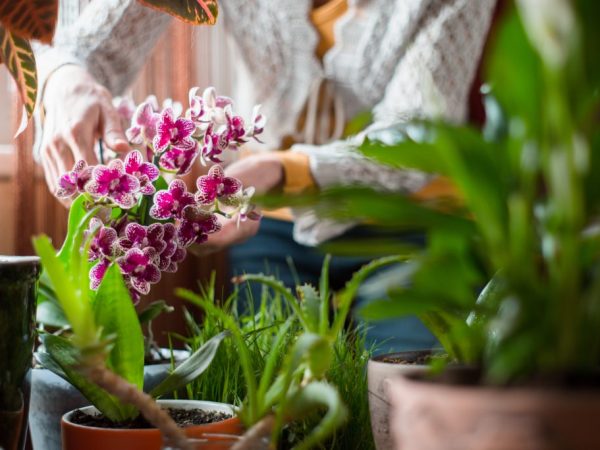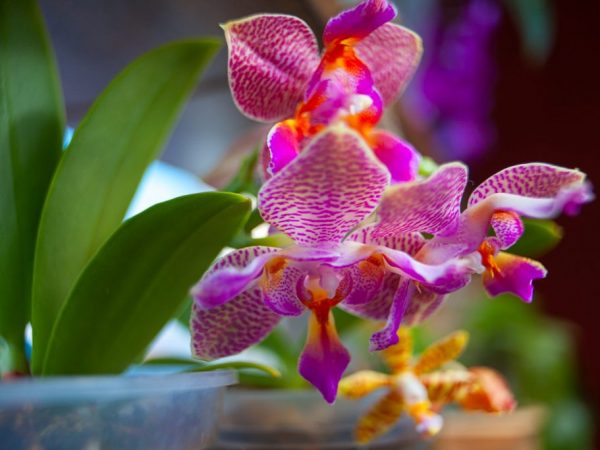Orchid care after purchase
An exotic orchid plant is often chosen by people to decorate their home. When buying an orchid, you need to understand that it requires careful care at home. However, if you know the characteristics of the plant and follow the basic rules for growing, caring for an orchid after purchase will not be difficult.

Orchid care after purchase
Description of the Phalaenopsis orchid
The homeland of the orchid is the hot and humid tropics, thanks to such conditions, the phalaenopsis is distinguished by its beautiful and abundant flowering of various colors and shapes. In real life, orchids live on tree trunks or on rocks; this type of life activity refers the flower to the genus of epiphytes.
Phalaenopsis has a developed root system, the roots are round, up to 0.5 cm in diameter. The deciduous cover is green, the leaves themselves are fleshy, smooth, green in color and oval or ellipsoidal in shape. The orchid blooms 2-3 times a year, the flowering is long, up to 3 months, the dormant period is not clearly marked.
Species diversity
There are 70 main varieties of orchids, while there are many more hybrids. Conventionally, there are giants up to 1 m high, and dwarfs no more than 30 cm. The color scheme is varied, there are white, yellow, purple, crimson and others.
Plant care at home
It is necessary to take care of the orchid regularly, without the conditions it needs, growth and flowering will be accompanied by problems.
Choice of substrate
The main component of the substrate is the bark. Before planting, rinse the bark and soak it for a couple of days in water, so it will pick up the moisture needed by the roots. Choose bark of different fractions, since a large one is laid on the bottom of the pot, and small in the middle and on top.
Cover the top layer of bark with moss, sphagnum will do, it will retain moisture for a long time. The soil should be free of peat and nitrogen fertilizers. When transplanting, place expanded clay or gravel on the bottom of the pot, in a layer of 2 cm, they will serve as a drainage cushion for the soil.
Pot selection
Orchid roots love light, they are actively involved in photosynthesis and require good access to light, and the grower needs to control their condition. It is convenient to keep phalaenopsis in a transparent pot, with smooth walls and drainage holes, for good air exchange.
Based on the size of the flower, choose the size of the pot, if it is small, the roots are injured. If there is a lot of space in the pot, excess moisture will collect and the roots will begin to rot.
Watering
The main indicator of moisture is the roots themselves, or rather their color. Green or light green do not need watering, become silvery - water. Another alarming signal is the lethargy of the leaves, there is also a lack of moisture. The water should be soft, at room temperature, orchids love melt or rainwater. When watering, be guided by the sequence, let the substrate dry.Also, alternate the method of watering, water the substrate from above for one week, without touching the leaves and trunk of the plant, and the next time place the pot in a large container of water for 20-30 minutes.
After watering, let the excess water drain, twist the pot, tilt it from side to side. In winter, be guided by the dryness of the substrate, but replace watering with spraying.
Lighting
At home, it is difficult to adapt phalaenopsis; in nature, the intensity of light changes throughout the day and season. For the development and flowering of an orchid, a change of lighting and a large amount of it are vital. In the spring and summer, keep the pot on the east windowsill, and in the winter and fall, south and west windows are better suited.
If there is not enough lighting, use fluorescent lamps, they should not be used constantly, but only in the evening from 18:00 to 22:00. When choosing a place for phalaenopsis, exclude direct sunlight, they will leave burns on the foliage.
Temperature

The flower does not like temperature changes
Regardless of the season, the temperature for phalaenopsis should not change much. In summer, 20-25 ° C is considered optimal, in winter it is not lower than 20 ° C. Also take into account the night temperature difference, it should not exceed 5 ° C.
Humidity
Humidity in apartments usually ranges from 40 to 70%, this is suitable for an orchid. Phalaenopsis flowers and buds dry, the leaves turn yellow, which means there is not enough moisture, use a household humidifier. Give the plant a warm shower regularly, sprinkling it generously.
Top dressing
In flower shops there are special fertilizers for orchids, they have step-by-step instructions on how to dilute the drug and use it at home. Top dressing should be carried out during flowering, in the summer 2 times a month, in the winter - once a month. Avoid fertilizers with potassium and phosphate salts, phalaenopsis does not tolerate them well, sheds leaves and stops flowering.
Transfer
There is no greater stress on the plant than transplanting. Planting an orchid in new soil is allowed only after flowering, during a dormant period. A transplant is needed in several cases, if the roots have grown so much that they do not fit in the pot, then divide the plant when transplanting. Or in case of damage to the substrate and damage to it by diseases or pests. Without an obvious need, it is better not to carry out it more often than once every 2-3 years. After the transplant, the orchid withers and gets sick. There are important points and stages in the transplant:
- remove the flower from the pot, cutting it with scissors without damaging the roots, and place the flower in a basin;
- rinse the roots thoroughly, remove dry and spoiled areas, residues of the substrate;
- inspect the trunk, remove dry and yellow leaves, dry peduncles;
- leave phalaenopsis overnight to dry the roots;
- prepare a new substrate and pot, replant the orchid and water.
Work only with a clean tool, disinfect all cut points and lubricate with crushed activated carbon.
Orchid propagation methods
The orchid has three breeding methods.
- For children - the simplest and most common. The procedure is best carried out in the first half of winter, a month after flowering. During this period, small children appear on the bases of the rosette and peduncles, they eventually take root and are ready for transplantation. They are separated from the mother plant when the babies reach a height of 5 cm.To stimulate the appearance of the baby, awaken the sleeping bud, increase the temperature in the room to 25 ° C, make a semicircular cut on the sleeping bud, choose the one closer to the base of the peduncle arrow. After a while, the cut will be covered with a scale, remove it with tweezers and treat the cut with a growth activator. A month later, subject to a high temperature, a baby will appear.
- Cutting is difficult to carry out at home, greenhouse conditions are needed. This type of reproduction is carried out during the dormant period of the plant. Use side shoots, at least 15 cm in length.Treat the pruning shears with alcohol and cut off the shoot at the base; the cut must be treated with crushed coal. We plant the stalk in a pot with a cut down, it is necessary to care for, as for an adult orchid.
- Split Socket - Suitable for most phalinopsis. First, prepare the soil, mix the bark and moss, slightly moistening them. With a sharp and disinfected pruner, cut off the top of the flower, grabbing a couple of leaves and roots, and place it in the prepared substrate. Immediately after the procedure, the cut must be processed with crushed coal.
Peduncle pruning
When starting pruning, make sure that the peduncle is dry and yellow, if you prune it earlier, new flowering will be delayed. If there is a bud on the peduncle, then the pruning is carried out higher so as not to damage a possible baby.
When cutting, leave a small stump, so it is more convenient to care for the cut area. Further processing of the cut with crushed coal is required. After pruning, repot and provide optimal care for your orchid.
Diseases and pests
After purchasing, inspect the plant for pests. A variety of slugs, millipedes, snails, spiders and ticks love to live in the leaves of phalaenopsis. They dine on the foliage, trunk and roots of the plant, preventing the orchid from growing and developing normally, and blooming in the future. Pests are harvested by hand, the flower is sprayed with warm water and a pest drug, it is advisable to take it from the store when buying the plant itself.
Fungal infections are dangerous for the plant, they provoke rotting of the roots and trunk, occur with excessive watering. If the fungus is not stopped in a timely manner, it will infect flowers and leaves, the plant will die. Use an antifungal agent, fungicides for prophylaxis, and transplant into a new substrate.
Bacterial infections also cause great harm, the leaves turn yellow sharply, darken over time, become lethargic and wrinkled, weeping spots appear with an unpleasant smell of rot. Isolate the orchid, trim off affected areas, and iodine the sections. After treatment with an antifungal drug, the flower is returned to its original place.
The most dangerous are viral diseases, they cannot be diagnosed without laboratory tests, and the plant withers before our eyes. All that can be done is to provide her with the most careful and attentive care, isolating her from other plants and giving her time to heal on her own.
Conclusion
The orchid gets used to the conditions in the greenhouse, after purchase, give it time to adapt. Provide optimal care for your orchid and it will repay you with abundant flowering and good health.

